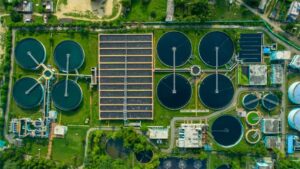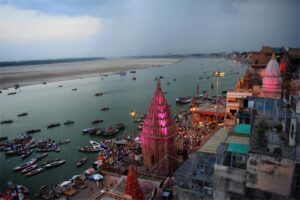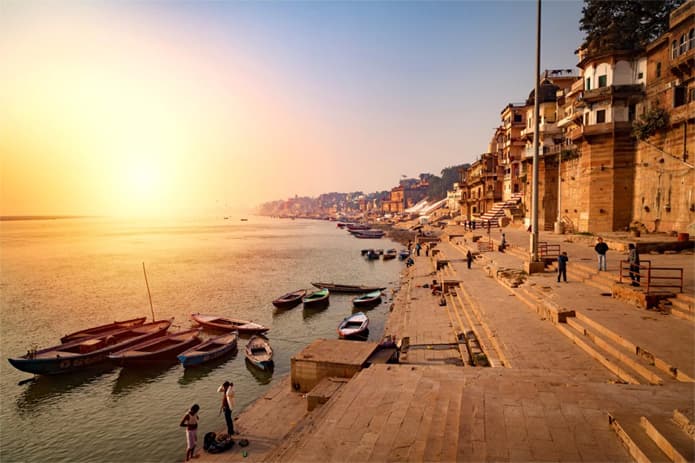By Our Correspondent
Varanasi, May 31: Through the Namami Gange Mission, the Government of India is making dedicated efforts towards the conservation of the Ganga River. As a result, the flow and cleanliness of the Ganga in Uttar Pradesh have significantly improved. To enhance the water quality of the Ganga and its tributaries in the state, the focus is on developing various infrastructure projects, including sewerage systems. The government is actively working on the revitalization of these rivers, resulting in the Ganga water becoming potable. Furthermore, the restoration of biodiversity and the river’s ecosystem has led to a notable increase in the population of various species, including Gangetic dolphins, otters, and turtles.

Under the Namami Gange Mission, 17 projects are in various stages in Varanasi, with a total investment of Rs 1,469 crore. Effective sewerage schemes are being implemented in the city to ensure a clean and uninterrupted flow of the Ganga. Key projects include the Dinapur STP with a capacity of 140 MLD, the Ramna STP with a capacity of 50 MLD, the Ramnagar STP with a capacity of 10 MLD, the old Dinapur STP with a capacity of 80 MLD, and the Bhagwanpur STP with a capacity of 9.8 MLD. All these facilities are now operational. Recognizing current needs, approval has been granted for a new 55 MLD STP in Bhagwanpur. In the interim, the Advanced Oxidation Process STP of 30 MLD capacity in Nagwa purifies the wastewater. The Central Pollution Control Board has acknowledged in its report that following these development initiatives, there has been a consistent improvement in the levels of Dissolved Oxygen (DO), Biochemical Oxygen Demand (BOD), and Faecal Coliform (FC).

In Varanasi, 22 out of the 23 drains that discharge directly into the Ganga from the left side have been completely tapped, with the Nakkhi drain partially tapped. In addition, 50 MLD of wastewater from the Assi drain, one of Varanasi’s major drains, is treated at the Ramna STP. Despite this, the remaining 20 MLD of wastewater is being purified through the ‘Advanced Oxidation Plant’ initiative under the Namami Gange program, ensuring that contaminated water is not released directly into the Ganga.
Simultaneously, five drains on the right bank of the Ganga have been completely tapped and diverted to a 10 MLD capacity STP in Ramnagar. In the Sujabad area, a project to develop a 7 MLD STP under Amrit 2.0 has been initiated. Additionally, more than half of the drains that flow directly into the Varuna River, which subsequently pollutes the Ganga, have been fully tapped. A plan is being developed to tap the remaining drains through the Goithaha STP.

Under the Namami Gange Mission, various projects aimed at rejuvenating the Ganga in Varanasi are underway. These include the improvement of interception sewers, trunk sewers, and rising mains for the Assi and Varuna rivers, along with the development of three sewage pumping stations. Additionally, a 140 MLD STP at Dinapur is being developed, and the old trunk sewer is being rehabilitated. Five pumping stations and the existing STPs at Dinapur and Bhagwanpur are also being upgraded. These efforts, undertaken by JICA, have an estimated cost of Rs. 660 crore.
Apart from cleaning and maintenance of 84 ghats in Varanasi, 26 ghats have been repaired and eight ponds have been revived. The river surface has been cleaned using mechanical trash skimmers. Furthermore, a battalion of ex-servicemen, known as the Ganga Task Force, has been established in Varanasi. This task force is engaged in activities such as plantation, monitoring, and conducting awareness campaigns along the river ghats.
Another crucial aspect of the Namami Gange program is to transform this mission into a mass movement i.e. Jan Bhagidari. Various collaborations and programs are being organized to engage people extensively in the Clean Ganga initiative. Ongoing programs involve partnerships with Gangadoot, Ganga Prahari, and Ganga Vichar Manch. Regular events like Ganga Swachhata Pakhwada, Ganga Utsav, and Yoga on Ghat are also conducted in collaboration with the District Ganga Committee to raise awareness about the significance of the River Ganga.


